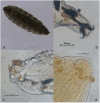First Report of Bronchial Oestriasis in a Domestic Dog
- PMID: 40856170
- PMCID: PMC12378664
- DOI: 10.1002/vms3.70583
First Report of Bronchial Oestriasis in a Domestic Dog
Abstract
This study reports the first case of bronchial myiasis in a dog caused by Oestrus ovis, a parasite known to infest sheep, and occasionally other mammals. A 9-year-old dog, from a rural area near Ancona (Italy), exhibited persistent coughing despite antibiotic and anti-inflammatory treatments. Bronchoscopy revealed a live first-instar larva of O. ovis, confirmed through morphological and molecular analyses. Larval removal and treatment with isoxazolines resulted in a rapid resolution of symptoms. This case highlights the critical importance of including atypical parasitic infestations in the differential diagnosis of respiratory symptoms in dogs. It underscores the importance of heightened vigilance, particularly in areas with sheep flocks, to prevent and manage such infestation effectively.
Keywords: Oestrus ovis; bronchoscopy; dog; first instar larva; myiasis.
© 2025 The Author(s). Veterinary Medicine and Science published by John Wiley & Sons Ltd.
Conflict of interest statement
The authors declare no conflicts of interest.
Figures


Similar articles
-
Unravelling the role of Calliphoridae (Insecta: Diptera) as a causative agent of myiasis in sheep with Chrysomya megacephala (Fabricius) as the first documented agent of myiasis in ruminants from Kashmir Himalaya, India.Vet Parasitol Reg Stud Reports. 2025 Aug;63:101298. doi: 10.1016/j.vprsr.2025.101298. Epub 2025 Jun 14. Vet Parasitol Reg Stud Reports. 2025. PMID: 40803791
-
Canine intestinal pseudomyiasis by blow flies and first documented case report caused by Lucilia cuprina in Central America.Parasitol Int. 2025 Dec;109:103084. doi: 10.1016/j.parint.2025.103084. Epub 2025 May 7. Parasitol Int. 2025. PMID: 40345641
-
Hemorrhagic gingival and tracheopulmonary myiasis: literature review and case report of Chrysomya megacephala in a patient with HIV/AIDS and likely histoplasmosis.J Med Entomol. 2025 Jul 17;62(4):1037-1041. doi: 10.1093/jme/tjaf064. J Med Entomol. 2025. PMID: 40578605 Review.
-
A Rare Case of Pseudomyiasis in a Dog by Hermetia illucens (Diptera: Stratiomyidae).J Med Entomol. 2019 Oct 28;56(6):1726-1728. doi: 10.1093/jme/tjz106. J Med Entomol. 2019. PMID: 31237327
-
Urogenital myiasis by Cordylobia anthropophaga.J Pediatr Adolesc Gynecol. 2013 Dec;26(6):e123-5. doi: 10.1016/j.jpag.2013.04.008. J Pediatr Adolesc Gynecol. 2013. PMID: 24238268
References
-
- Azoulay, F. , Girard N., Gatel L., Besson J., and Fritz J.. 2023. “ Oestrus ovis Sinusitis in a Dog.” Veterinary Record Case Reports 11, no. 4: e706. 10.1002/vrc2.706. - DOI
Publication types
MeSH terms
LinkOut - more resources
Full Text Sources
Medical

